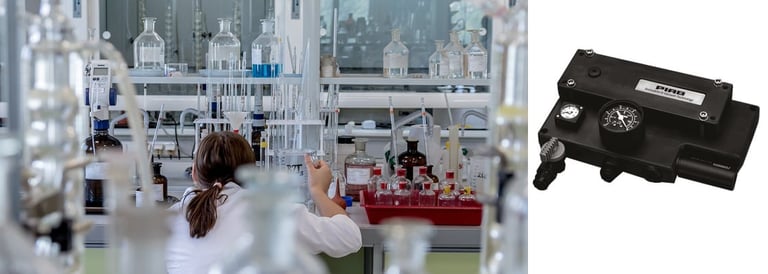使用 Piab 的真空技术轻松分离样品

样品分离是化学实验室进行下一步研究的常规任务。Piab 的 Lab Vac 真空发生器可保证基于标准压缩空气系统的能源、成本效益和可靠工艺。
当涉及分离旋转蒸发时,真空过滤、脱气和凝胶干燥作为电泳的先决条件是从液体溶剂或气体中分离反应合成产物的常用方法。真空技术在所有这些技术中都发挥着重要作用。
虽然吸水是一种简单的技术,安装成本最低而运行成本最高,但真空质量差是其最大的缺点。此外,在越来越多的地区面临降雨较少的干旱时期,需要考虑其将水作为资源产生真空的非可持续使用方式,因为它可能对供水产生严重影响。随着市政供水公用事业成本的增加,这一事实更有可能推高运营成本。
因此,通常在中央真空系统或带有便携式真空发生器(例如,Piab 的 Lab Vac 多级发生器)的压缩空气驱动解决方案之间进行选择。
由于实验室中可能已经有中央真空系统,因此真空质量取决于用户数量,限制了可以同时进行的过滤次数。如果安装了附加系统,则需要为具有足够冷却能力的真空发生器提供专用空间,以应对系统产生的高热负荷。虽然运行成本比吸水略为便宜,但由于基于用户的溶剂集中器效率低下,维修成本往往更高,这会缩短泵的使用寿命,并且由于溶剂污染而需要频繁更换泵油。
根据真空发生器的使用灵活性,安装成本与中央真空相似或最多低 25%,采用 Piab 的 Lab Vac 真空发生器的压缩空气驱动解决方案是最经济的。考虑到其在没有移动部件的情况下运行,运营成本降低了近 80%,而维护成本可以忽略不计,所以这一点尤其正确。与中央真空系统中使用的典型电动真空发生器相比,Piab 的 Lab Vac 真空发生器可以说是免维护的,因为无需换油,电机不会产生火花或磨损,运行期间也不会产生热量。
虽然它需要足够的空气容量来驱动所选数量的真空发生器,但 Lab Vac 发生器是完全便携的,因此可以在需要的位置灵活操作,即使需要通过软管覆盖更长的距离到中央空气系统,也不会造成真空损失。由于它们在所有位置的使用点提供一致的真空水平,因此真空质量非常好。因此,Piab 的 Lab Vacs 是最可靠的真空源,可确保结果的可重复性和可比较性。这一点很重要,因为来自旋转蒸发或真空过滤的样品通常构成进一步测试的基础,这些测试取决于基础材料的质量和纯度,以获得可靠的结果。
Piab 的 Lab Vac 多级发生器的特点是高真空流量和高真空度。这对于旋转蒸发具有较高沸点的溶剂(如水)以及另一种经常使用 Piab 的 Lab Vac 真空发生器的应用——凝胶干燥非常重要。这里需要相对较高的流速,因为在凝胶干燥中可能存在高泄漏率,而凝胶干燥可在例如电泳中用于分离和确定 DNA 片段或蛋白质或用于储存这些材料以备后用。
在这两种应用中,真空调节都是有益的。在旋转蒸发中,它通过提供均匀的蒸发速率来帮助防止样品碰撞。在凝胶干燥中,它可以设置最佳压力以防止凝胶撕裂。为此,Piab 的 Lab Vac 真空发生器可以配备额外的 Vacustat 止回阀。它不仅可以微调真空度并将其调整到所需的准确水平,还可以实现间歇操作,这与需要连续运行的电动泵或水喷射真空泵等传统源相反。因此,当达到所需的真空度时,Vacustat 会减少真空发生器的运行,使其仅需要保持预设的真空度,从而将能耗降至可能的最低水平。
由于实验室设备通常暴露在恶劣的环境中,因此耐化学性起着重要作用。Piab 的 Lab Vac 真空发生器完全由 PPS 制成,密封件由 EPDM、Viton 或 KalRez® 制成,具体取决于所用溶剂的腐蚀性。
尽管有水喷射真空泵或电动泵,但多级真空发生器对操作员非常友好,因为它们不会因众多运动部件而产生持续的噪音。这使得操作员可在很长一段时间内连续提取样品而不会感到疲倦。
Piab Lab Vac 专为现代实验室使用而设计,是一款非常小巧的便携式真空设备,可以安装在使用点附近,从而腾出工作台和过道空间,并为研究人员提供更多工作区域。同时,它减少了线缆损耗并提高了任何类型样品分离的可靠性,无论是旋转蒸发、真空过滤、脱气还是凝胶干燥。